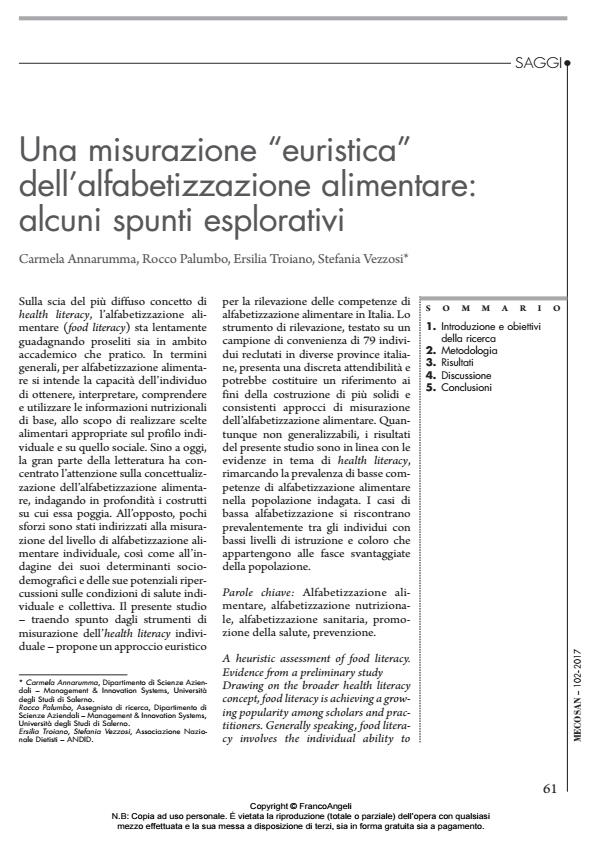Una misurazione "euristica" dell’alfabetizzazione alimentare: alcuni spunti esplorativi
Titolo Rivista MECOSAN
Autori/Curatori Carmela Annarumma, Rocco Palumbo, Ersilia Troiano, Stefania Vezzosi
Anno di pubblicazione 2018 Fascicolo 2017/102
Lingua Italiano Numero pagine 23 P. 61-83 Dimensione file 23750 KB
DOI 10.3280/MESA2017-102004
Il DOI è il codice a barre della proprietà intellettuale: per saperne di più
clicca qui
Qui sotto puoi vedere in anteprima la prima pagina di questo articolo.
Se questo articolo ti interessa, lo puoi acquistare (e scaricare in formato pdf) seguendo le facili indicazioni per acquistare il download credit. Acquista Download Credits per scaricare questo Articolo in formato PDF

FrancoAngeli è membro della Publishers International Linking Association, Inc (PILA)associazione indipendente e non profit per facilitare (attraverso i servizi tecnologici implementati da CrossRef.org) l’accesso degli studiosi ai contenuti digitali nelle pubblicazioni professionali e scientifiche
Sulla scia del più diffuso concetto di health literacy, l’alfabetizzazione alimentare (food literacy) sta lentamente guadagnando proseliti sia in ambito accademico che pratico. In termini generali, per alfabetizzazione alimentare si intende la capacità dell’individuo di ottenere, interpretare, comprendere e utilizzare le informazioni nutrizionali di base, allo scopo di realizzare scelte alimentari appropriate sul profilo individuale e su quello sociale. Sino a oggi, la gran parte della letteratura ha concentrato l’attenzione sulla concettualizzazione dell’alfabetizzazione alimentare, indagando in profondità i costrutti su cui essa poggia. All’opposto, pochi sforzi sono stati indirizzati alla misurazione del livello di alfabetizzazione alimentare individuale, così come all’indagine dei suoi determinanti sociodemografici e delle sue potenziali ripercussioni sulle condizioni di salute individuale e collettiva. Il presente studio - traendo spunto dagli strumenti di misurazione dell’health literacy individuale - propone un approccio euristico per la rilevazione delle competenze di alfabetizzazione alimentare in Italia. Lo strumento di rilevazione, testato su un campione di convenienza di 79 individui reclutati in diverse province italiane, presenta una discreta attendibilità e potrebbe costituire un riferimento ai fini della costruzione di più solidi e consistenti approcci di misurazione dell’alfabetizzazione alimentare. Quantunque non generalizzabili, i risultati del presente studio sono in linea con le evidenze in tema di health literacy, rimarcando la prevalenza di basse competenze di alfabetizzazione alimentare nella popolazione indagata. I casi di bassa alfabetizzazione si riscontrano prevalentemente tra gli individui con bassi livelli di istruzione e coloro che appartengono alle fasce svantaggiate della popolazione.
Parole chiave:Alfabetizzazione alimentare, alfabetizzazione nutrizionale, alfabetizzazione sanitaria, promozione della salute, prevenzione.
Carmela Annarumma, Rocco Palumbo, Ersilia Troiano, Stefania Vezzosi, Una misurazione "euristica" dell’alfabetizzazione alimentare: alcuni spunti esplorativi in "MECOSAN" 102/2017, pp 61-83, DOI: 10.3280/MESA2017-102004